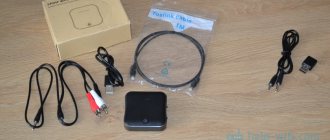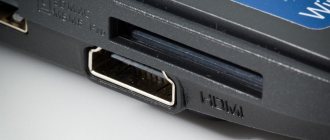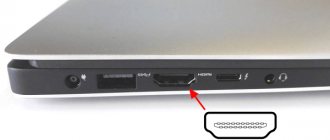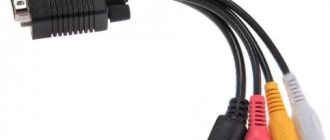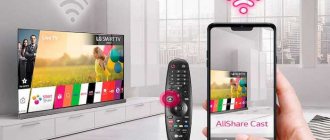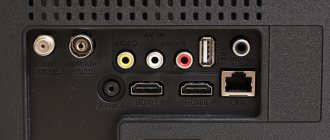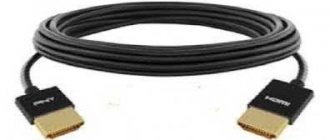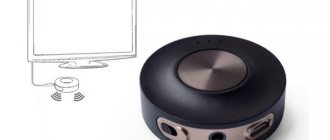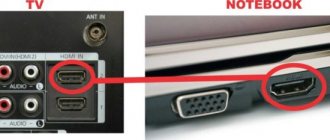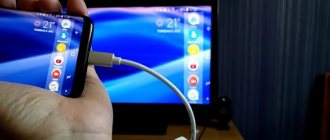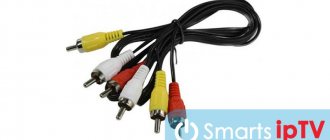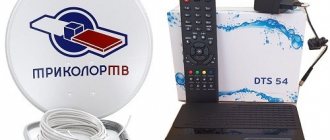Synchronization with a PC will significantly expand the functionality of the TV. Therefore, it is not surprising that all users want to know how to connect a computer to a TV? Note that there are a huge number of different methods, each of which we will carefully analyze. Much will depend on the TV model. Old equipment is equipped with connectors that are not found on computers. Because of this, certain difficulties may arise.
A PC is connected to an LG TV or equipment from any other manufacturer using special cables. There are also wireless synchronization methods. However, not all TVs are equipped with a built-in Wi-Fi module, which is necessary for a wireless Internet connection.
Why is this necessary?
Each user must independently determine whether it makes sense to connect the TV to the computer? For example, if you only watch preset channels, then connecting your PC to your TV is unlikely to be of much use to you. To a greater extent, such synchronization will be of interest to users who want to watch new movies, TV series and other content.
Outputting images from a computer to a TV will definitely expand the functionality of the equipment. After setting up this connection, you will be able to:
- play video games on the big screen TV;
- watch films, TV series, videos;
- communicate with friends and acquaintances via Skype;
- make presentations.
The resolution and color saturation of modern TVs from Samsung, Sony, and LG are much higher than those of an inexpensive computer monitor. Therefore, synchronizing your equipment will allow you to watch new films in excellent quality. This is especially true if you purchased a device without a built-in Wi-Fi module and Smart TV support.
Setting up a TV as a monitor is much easier than it might seem at first glance. Every user can cope with this task. It is enough to decide on the synchronization method and also acquire the necessary cord. It is possible that you already have the necessary cables at home.
Connect using an HDMI cable
If your screen does not have a wireless adapter, but has an HDMI input, it is still possible to connect it without using a wire. You only need a small device, which is purchased separately, for example:
- Google Chromecast - allows you to cast data from your devices to your TV.
- Android Mini PC – connects any device running Android OS to your TV. Great option for phones and tablets.
- Intel Compute Stick is a miniature computer connected to an HDMI port.
How to connect a Samsung printer to a laptop
Connect any of these devices to your TV, and your laptop or tablet will begin to see it in the list of active connections.
Connection options
How to connect a computer to a TV? Conventionally, all existing methods can be divided into two large groups - wireless and using cable. When choosing one method or another, take into account the technique used. See which computer and TV inputs can be used for synchronization.
First, we will briefly list the methods that ensure broadcasting of TV images on a large screen without loss of quality. If none of these options work for you, then you can use less popular connectors.
As mentioned earlier, it is likely that you will have to purchase a specific cable additionally. The cost of such wires is minimal. If you plan to use adapters, then you should go to an electronics store. This scenario is relevant in cases where an old PC or TV is used.
All kinds of additional coverings for cords are advertising tinsel. This aspect does not in any way affect the quality of the transmitted image. Think carefully about how long the cable should be for your convenience. It is important not only to set up the connection, but also to maintain the aesthetic appearance of the room.
The easiest way to connect an LCD TV to a computer is an HDMI cable. Firstly, absolutely all modern technology is equipped with this interface. Secondly, it transmits audio and video simultaneously. Alternatively, you can use one of the following options:
- VGA;
- DVI;
- S-Video;
- RCA.
All these connectors are obsolete. Therefore, they should only be used if you are using old equipment. HDMI remains the priority.
Let's say a few words about wireless synchronization. This option assumes that your TV will have a built-in Wi-Fi module. Mostly they are equipped with models that support Smart TV. Today you can purchase an adapter for a wireless Internet connection and insert it into a regular TV.
HDMI
An HDMI cable is not included in the basic package of your computer or TV. Therefore, this cable will have to be purchased separately. In electronics supermarkets they are presented in a wide range. Wire length from 1 to 20 meters. There will be no problems with the choice. Once the cord is purchased, find the corresponding ports on the TV and PC.
How to connect a TV through a computer via HDMI? Follow the step by step instructions:
- Insert one end of the cable into the TV connector, it is located on the back panel or side.
- Connect the second plug to the computer system unit.
- Open the TV menu.
- Select “HDMI” as the signal source.
- Configure settings for displaying images on a large screen.
Old computers do not have an HDMI connector. The problem is solved by purchasing an adapter. For example, a USB to HDMI adapter will work for you.
Mostly, the default settings set the picture to be displayed only on the second display, which is the TV screen. Due to the difference in resolution between TV and PC, the image may not be displayed correctly. Therefore, you need to open the Windows operating system settings and make changes to some parameters.
Open the “Display” menu and select “Multiple Monitors” from it. You should definitely activate the display duplication function. After this, the problem should disappear. The computer desktop will appear on the TV screen.
How to improve picture quality? Go to personalization and then change the resolution. However, it is possible that the resolution will be selected automatically. If not, then set your TV resolution. The image quality will increase noticeably.
WiFi
Wireless networks can also be thought of as a way to connect your TV to your computer. What is needed for such synchronization? First, you need to study the specifications of your LCD or plasma TV. Unfortunately, only modern models support data transfer by setting up a Wi-Fi connection. If your model does not support a wireless Internet connection, then buy a special adapter. It is connected via a USB connector.
Connecting your PC to your TV wirelessly has obvious advantages:
- Internet access;
- viewing content saved on the PC hard drive;
- simple connection process;
- free arrangement of devices;
- no wires.
To configure such synchronization, you need to use a special utility. The software comes with the TV. If the disk with the software was not included in the basic package, then download the program from the official website of the equipment manufacturer.
The main function of the software is to quickly connect a PC to a TV via a home Wi-Fi network. The utility's interface is extremely simple and clear. You will need to create a special directory on your computer’s hard drive through which content for TV will be sent.
Many users solve such problems using another router. A single wireless network will cover absolutely all devices, including the TV. Therefore, you can play all kinds of files on the big screen.
S-Video
Another way to synchronize TV and PC is to use the S-Video interface. This option is good because absolutely all equipment is equipped with such a connector. An exception may be computers with extremely old GPU modules. Another strength of this synchronization is its simplicity. The user just needs to connect the S-Video connectors on the PC and TV using a cable
Before connecting the TV to the computer via the S-Video interface, you need to turn off the equipment. One end of the cable is inserted into the connector on the PC video card - a round black socket. The other plug is connected to the corresponding TV input; it is located mainly on the rear panel of the device.
Turn on the TV first, and then the PC. As the operating system loads, the TV screen will begin to flash - this is a sign that a new signal source has been identified. Now the user's task is to configure the GPU module. Right-click on the desktop, select “Properties” from the context menu, go to the “Options” section.
Open the "Advanced" item. In the dialog box that appears, opposite the name of the GPU, check the “Clone” box. When the parameter is applied, click on the “Display” section. From the list that opens, you need to select the name of the TV. Take the TV remote control and set the appropriate signal source. In our case, this is the S-Video connector. When the image appears on the big screen, you can proceed to adjust it. Now you know how to connect a computer or laptop to an old TV.
Miracast
Many users confuse this technology with DLNA. In fact, it differs in that it significantly simplifies the playback of not only files stored on the PC hard drive, but also allows you to play content online. For example, you can turn on your favorite movie or a new episode of a popular show using a regular browser.
To use Miracast technology, you need to have a powerful computer. This is because it is a resource-intensive application. Therefore, synchronization via Miracast is relevant among owners of PCs, laptops and tablets with powerful hardware.
How to set up a TV if it supports the technology in question optionally? You need to purchase a special adapter. It connects to the device via HDMI. The wireless monitor technology is characterized by maximum ease of use. The image displayed on the large screen will be broadcast using a special algorithm. The image is mirrored via Wi-Fi to a large TV screen.
The user does not need to connect the TV to one of the local networks using a router. With the help of routers, a mini-network is created, which greatly simplifies synchronization with a PC. You will need a program to connect a wireless monitor - the Wireless Display utility. When the add-on is installed, you can start broadcasting.
Make sure that the Miracast option is enabled in the TV menu. You can activate this feature in the settings. Open the “Networks” tab, and then go to the “Intel WiDi” subsection.
VGA and DVI
How to connect an old TV to a computer? DVI and VGA connectors are ideal for this task. Let's look at each of them to determine the features and rules of such synchronization. Let's start with VGA. Almost all equipment is equipped with this interface. The exception is inexpensive laptops and netbooks. The VGA connector is standard and also the oldest method of analog connection of TV to system units.
Why is VGA considered obsolete, and in what ways is it inferior to HDMI? Firstly, image transmission is carried out through analog signals. Secondly, by today's standards, the speed of information transfer is extremely low.
If the equipment you use is equipped with this interface, and you also have a VGA cable, then there should be no problems with connection and subsequent setup. Step-by-step instruction:
- Insert the wire plugs into the corresponding connectors.
- Turn on the equipment.
- Select VGA interface as the main signal source.
- Make the appropriate settings in the Windows operating system.
The connection process itself should not cause any difficulties. Mostly users have questions regarding the setup. If you ignore this stage, then the user will absolutely not be able to achieve the transmission of a high-quality image.
If the picture is not transmitted to the TV screen, and certain problems, interference, and defects are visible, it means that the user has specified incorrect settings. Particular attention should be paid to the picture broadcast mode. There are two modes - “Only on TV”, “Display and TV at the same time”.
Before connecting your TV to your PC using the VGA interface, you need to configure the operating system accordingly:
- Right-click on the free space on your desktop.
- From the context menu, select the “Screen Resolution” section.
- Open the Screen menu.
- Select one of the available image broadcast modes.
- Save your changes.
As you can see, connecting a PC and TV via VGA is as simple as possible. The main thing is to set the necessary parameters.
The DVI interface is considered more modern and advanced when compared to VGA. Firstly, both analog and digital signals are transmitted. Secondly, there is a gradation of the interface into groups with a specific, narrow focus:
- DVI-D – designed for digital connection;
- DVI-A – suitable for analog signals;
- DVI-I is a universal option.
As for the connection process itself, it is carried out in the same way as in the case of other interfaces. First, the user connects the cable plugs to the connectors of the TV and computer, and then selects the appropriate signal source.
DVI cable
Devices with a DVI connector instead of HDMI are extremely rare. If the laptop has a video card equipped with a DVI connector, with a DVI adapter you can transfer the image from the computer monitor to the television monitor. But only the image will be transmitted, since sound is not transmitted in this way. To transmit sound you will have to use speakers or headphones connected via a minijack.
Setting up your TV
After connecting, you need to configure it. In most cases, devices sync automatically, but sometimes you need to manually configure the settings.
Automatic setup
Automatic parameters are configured immediately after connecting the devices. The TV will simply appear in the list of active wireless connections. All you have to do is simply select the movie you want and turn it on - it will immediately start playing on the TV screen.
For normal synchronization, it is recommended to check the relevance of the drivers installed on the laptop’s video card, and update them if necessary.
Adapters and converters
Various connectors can be used to transmit video and audio signals. To ensure data transmission through them, sometimes it is enough to use an adapter. In this case, use a cable that has suitable plugs. In this case, the contacts in them are connected in such a way as to ensure the transmission of signals to the required contacts. This is possible provided that the corresponding pins are present in both connectors.
In some cases the situation is fundamentally different. For example, the video card in the computer system unit has a DVI-D, and the TV has a VGA port.
If you look at the description of the DVI-D contacts, you will notice that some of the contacts responsible for the analog component of the sound and which are needed for the operation of the VGA connector are missing. It is not enough to simply connect the contacts in the correct order. And it is necessary to provide complex signal conversion. To work, you will need not an adapter, but a converter.
